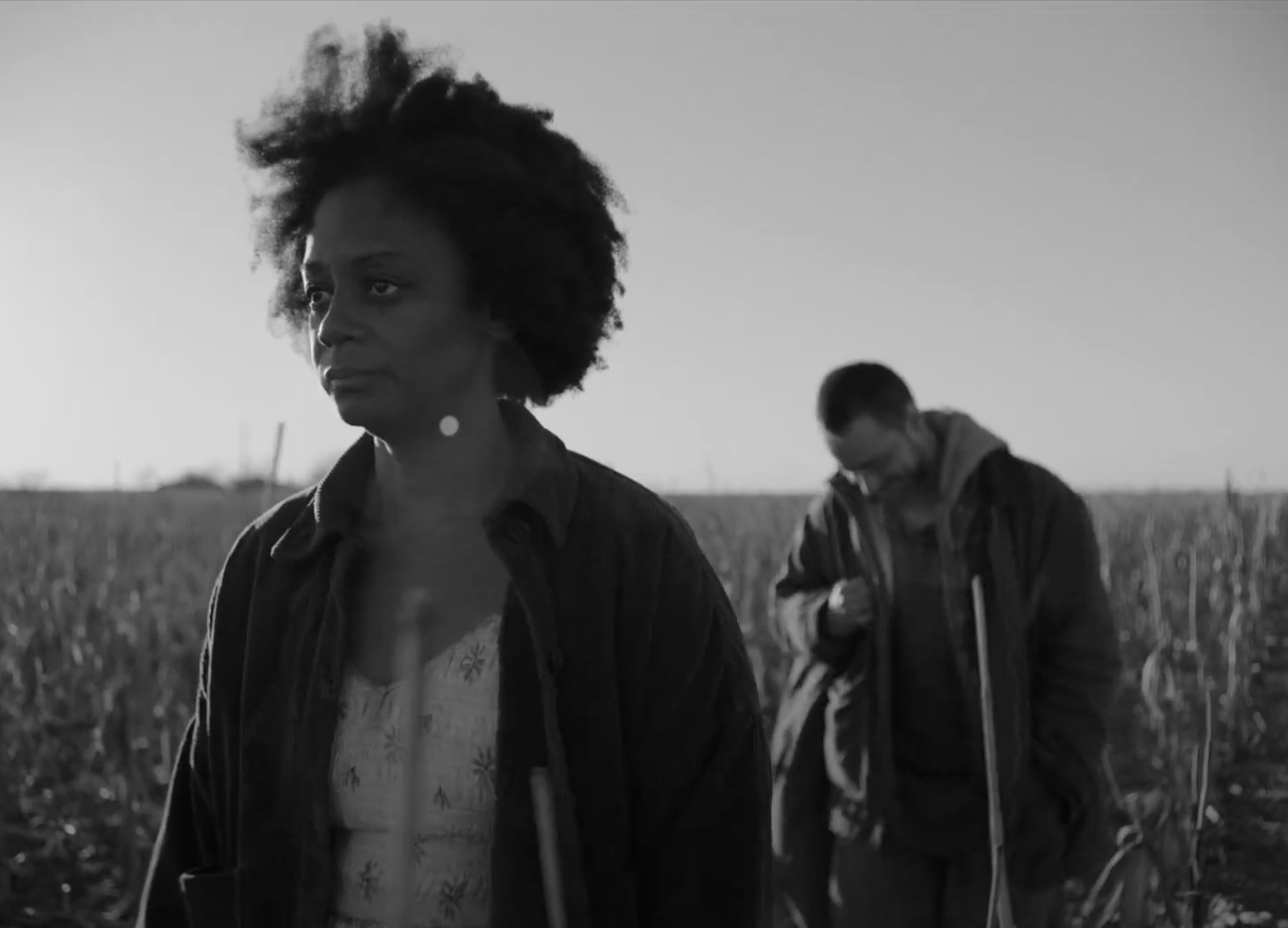
‘Fugitive Dreams’ Tells a Timeless Tale for Right Now
Austin-based director Jason Neulander and two Texas actors bring a play about homelessness, police violence, and illness to the screen.

A version of this story ran in the January / February 2021 issue.
Above: In 'Fugitive Dreams,' characters John and Mary are drifters navigating a complex ecosystem of obstacles to their safety and health.
John, a nervous chatterbox with a child’s innocence, retches under a tree on the side of the road. “Dust in the lungs,” he says. His companion, the downhearted Mary, forces him to stand and leads him out of sight. “Cops’ll beat you dry for that shit,” she says in a low voice. “Get up.” Dried-up cornstalks stretch out for miles as the two characters in shoddy coats walk through the flat land in harsh black and white. The threatening landscape seems to trail them.
This moment in Fugitive Dreams, the debut feature film from Austin director Jason Neulander, exposes early on that despite its appearance as a period piece, in more ways than one it’s a film about our new decade. John and Mary, drifters who have had to steal to eat, are navigating a complex ecosystem of obstacles to their safety and health, and the specter of the “cop” turns out to be at the heart of it.
Shot in the Austin area, Fugitive Dreams had its U.S. premiere at the Austin Film Festival in October and is making its way through rounds at other festivals now. Neulander adapted the script from a 2000 play titled Fugitive Pieces, in collaboration with original playwright Caridad Svich. In 2002, Neulander directed a production of the play at the Hyde Park Theatre in Austin. He wanted actress April Matthis for the role then, but it didn’t work out until now—she plays Mary in the film, alongside co-lead Robbie Tann. They’re Texans as well: Matthis grew up in Texarkana and Tann in Dallas.
An ambitious allegory touching on homelessness, abuse, and exploitation, Fugitive Dreams is a timely tale told in a fantasy world of the past. Vaguely set in the Midwest—one character mentions Ohio—and untethered to any specific time period, the film floats between physical and temporal spaces with a bizarre, uncanny tone. Its roots as a play are visible, but the script translates into cinema with intense visual beauty. Inspired by the photography of Dorothea Lange and stories of the Dust Bowl, Neulander etches a portrait of a cruel landscape for these vulnerable figures to cross. There’s a “timelessness” to small-town Texas that lends itself to the project, Matthis told the Observer. “I feel it whenever I go back to Texarkana.”
In the second act, the film devolves into a nontraditional narrative morphing the makings of The Wizard of Oz into David Lynch-style nightmare sequences. All the while, Central Texas appears bitterly cold and utterly stranded, a canvas for the terror of these characters: A pitch-perfect use of sound makes it feel all the more merciless, exploiting howling winds, ominous birds, and odd frequencies. “I think God has abandoned us,” John speculates.
If its stylistic elements—its visual and sonic details—are one arm of Fugitive Dreams’ strengths, the acting is another. Character actors O-Lan Jones and Scott Shepherd add to brilliant, unsettling scenes, and Matthis and Tann play off each other to strike a delicate balance. His vivacious performance matches her stillness and resolve. Early moments of tenderness create the emotional power that sustains the later chaotic dreamscapes of the film: When John keels over with hunger, Mary tells him to “breathe, slowly, so it fills you up.” She shows him how to inhale until he feels full with guava cake and red wine.
In another moment, the actors take care to convey Mary’s experience of abuse at the hands of the police. During an argument, she shows John the scars on her back from a police beating, and implies she was sexually assaulted during the same experience. Later, after he stops her from cutting herself with a shard of glass, the two hop a rail car together, and she finally tells him her name. He asks, “Can I touch your back, Mary?” A guitar plays low over the rumbling of the train, the camera shaking slightly from motion, as she pulls her coat down, lying with her back to him as he gently reaches over in the darkness.
For a story exploring such serious themes, it doesn’t always do them justice. Given the film’s emphasis on police violence, it’s odd to see race wholly side- lined. Mary is Black and John is white, but this is never acknowledged. It feels like a glaring omission, especially around the uprisings of 2020, and calls up difficult questions about colorblind casting. The practice has been promoted by some as an important strategy to include actors of color in more productions, but opponents in theater and film, including playwright August Wilson, have called attention to its limitations. Wilson rejected that old adage “I don’t see color,” stating instead: “We want you to see us.” Regardless of the time period, Mary’s Blackness would have mattered.
In the Austin production of Fugitive Pieces in 2002, Mary was played by a white actress, but Matthis had almost joined the cast. Would they have ignored her race then, too? In the two decades between the theatrical production and the film, an anti-racist critique of police violence is something Neulander could’ve found.
Mary, who’s alone at the start of the film, seems positioned as an equal protagonist but doesn’t get the backstory or dimension that John does. By the climax of the film, her arc has become distinctly secondary, already having been stripped—a lengthy monologue she delivers in the play about where she got her scars was cut. Meanwhile, John’s experiences of domestic abuse at the hands of his step-brother, who was a cop, become the focus. It feels as though our attention is meant to be focused on John’s grappling with the fact that his brother may not be a “good cop,” which, at the end of the day, is not a particularly compelling revelation.
Still, the film’s power is in its recognition of how interconnected all these issues really are, an offering toward the present day. It daringly portrays the dark side of authority, the brutality of policing which comes down on the most vulnerable. And it explores that other invisible thing all around us these days, an evil hitting the poor and houseless hardest: illness. John’s mental well-being is a concern throughout the film, and the debilitating nature of mental illness is front and center as both characters cope with trauma. In the last act, John’s brutal cough reveals itself as a grave concern, and he struggles to resist a wave of vivid hallucinations. Mary wants to help him but has to do so out of sight. When she finds some medicine and can finally bring it to him, he grimaces: It tastes bad. “Like wine from a glass,” she tells him, asking him to imagine something better, something sweeter. In spite of it all, they dream together.
Read more from the Observer:
-
The Blacklist: Screened out by automated background checks, tenants who face eviction can be denied housing for years to come.
-
‘Chicano Squad’ Provides New Perspectives on Police Brutality and Unsolved Murders: Two native Texans teamed up to produce a just-released podcast that tells the story of an innovative group of Houston homicide detectives.
-
Musician Anjimile on Leaving Texas, Getting Sober, and Blowing Up: The Richardson-born singer-songwriter released his debut album in September.


